Most people venturing to Southeast Asian countries want to “experience” the wildlife. Whether that’s by swimming with whales, dolphins or sharks, riding elephants, or petting snakes…most (if not all) of these practices are unethical. As a wildlife lover, I was too aware of this, but I’m not going to lie and pretend… I also wanted to have some wildlife-related activities during my trip. As long as these were ethical. Would it be possible?
For the entirety of this trip, one of the hardest things for me to witness was how animal welfare is mostly disregarded in general, with tons and tons of tourist-related activities profiting from the exploration of wildlife. If you are truly passionate about wildlife and its conservation, it is important to do your due diligence when it comes to this.
I know that a lot of us fall into the trap of ignorance. Ignorance is a dangerous thing, and we humans have been raised to assume that other animals must subject to our will and desires. Throughout history, many animals have played an important role in helping the human civilization progress. I’m not even talking about hunting and phishing practices for our survival. I’m talking about how animals have been used throughout history for transportation, and heavy work such as in construction, logging, and even in wars. In a lot of regions in the world, they are still an essential part of all of this. Animals are also often used in religious ceremonies and rituals that may or may not require the animal to be killed, or sacrificed. And the worst part, often used for entertainment purposes…Don’t even get me started with bullfighting (still predominant in Spain and also my own country, Portugal… hopefully it’ll be over soon), cock fights, hunting for entertainment, as a sport… and then, there is tourism.
I strive to be a sustainable tourist, and that means accepting that I’ve made mistakes, I’ll continue to make them likely, but I’m learning continuously and changing my behaviour accordingly. One of the major learnings I made during the last decade of my life is to do my due diligence when it comes to the activities I shouldn’t take part in, even if they figure on the must-do lists of a tourist destination.
For some time I wanted to volunteer at an Elephant Sanctuary, but as I started to read about the bad practices of these self-denominated refugees, I started to hesitate. In addition to this, there is another element of voluntourism that really gets on my nerves – that you might be taking away the job of a local, likely someone who could make this their career. I really want to do a little bit of a deep dive on this topic, because I’m truly passionate about it. A lot of this passion has been only fed by my stay at the Elephant Conservation Centre (ECC) in Laos. Let me tell you a little more about it.
The Elephant Conservation Centre (ECC) in Laos
I spent months researching for my trip. I desperately wanted to be able to see elephants up close, but in a way that wasn’t harmful to them. Despite my desire, I would have given up, if I hadn’t found the ECC. I quickly realised most sanctuaries only care about making profits, and not about the elephants and their population.

That’s how I came across the ECC website. The first thing that came to my attention was that the name of this place didn’t include “sanctuary”. Secondly, it spoke about CONSERVATION as part of their mission. Indeed this place cares about rescuing elephants from dangerous situations (and this includes tourism practices), trying to get them to breed, and impressively, rewilding – meaning integrating them back into the wild, where they truly belong. And finally, the massive keyword I was looking for – EDUCATION. I also noticed they had been featured in major reference publications, including The Guardian, El País, Le Monde. The more I read about the place, the more interested I was getting.

Learning at the ECC
In this place, you don’t come to pet the elephants, bathe them, feed them… no. That job is left to the professionals – the mahouts. You, as a guest, and in a way, as a patron, are simply the observer… and the student as well. This is what I call sustainable tourism. When you stay with them you not only get a masterclass about elephants, specifically the Asian Elephant, but your money is also reinvested in the right place, into conservation efforts.





At the time of my visit, there were two different packages. You can stay one night, with a day and half of activities, or 2 nights, with two days and half of activities. I stayed 2 nights. The additional activities mean that you end up spending more time observing the elephants, with more chances of seeing them engaging differently. We also had the chance to see the males socializing, which those who only stay for one night don’t.
The activities mostly include observation of the elephants (bathing, feeding, socialising) and it may involve a little bit of hiking but nothing too strenuous. In fact, the views are absolutely beautiful, so personally, I really enjoyed it. We also spent some time with the resident veterinary and heard him explain the main challenges the elephant population faces in Laos to more practical things (such as how to care for an injury). It does involve hearing a lot of incredibly heartbreaking stories about newborn elephants not making it or female elephants miscarrying. So be prepared to feel that knot in your throat.



The place itself is stunning, and you can see how these elephants might feel at home. It’s in the middle of the forest, with about 6000 hectares and a beautiful artificial lake. There were in total 30 resident elephants – some of them belong to the centre, some to the government. This in itself says a lot about the credibility of the place – one of the latest elephants had been saved from being exported to Dubai for a private owner! So the government took it to the centre, to be taken care of.
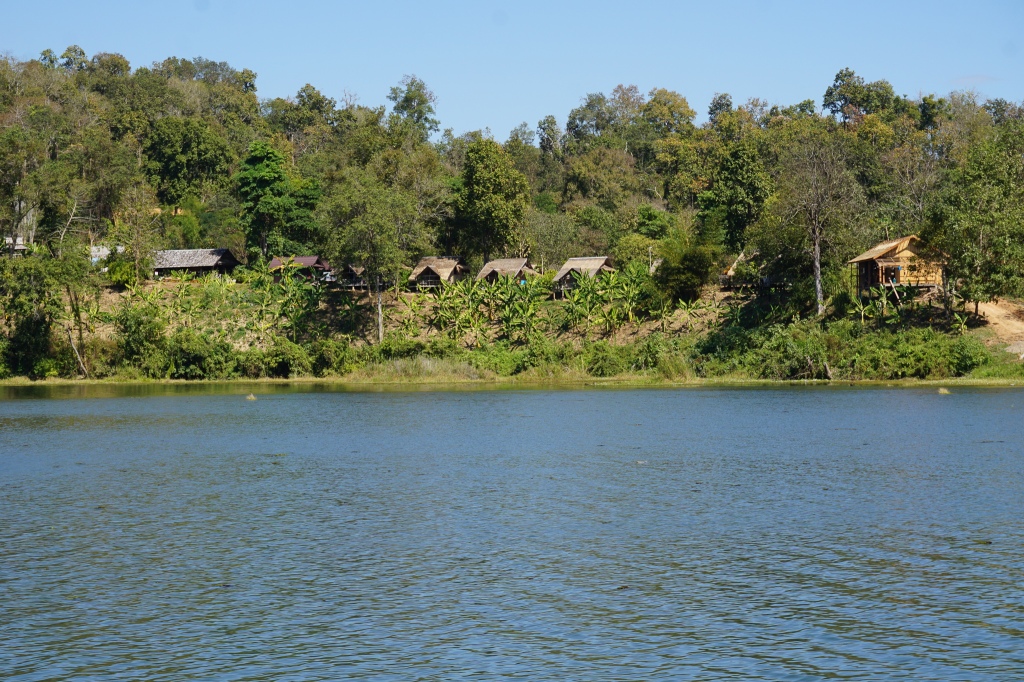

You stay overnight in your own little hut, which comes with a bed, a mosquito net, a little table and a lamp. The hut also had a little balcony with a couple of chairs, perfect to relax at the end of the day. Bathroom facilities were shared. Everything was incredibly clean, even though you were in the middle of the forest, which I found impressive! Of course, there were some insects here and there… and the geckos’ call often woke me up in the night, but something you quickly get used to when spending some time in Southeast Asia! My biggest fear was encountering a massive spider… which I didn’t thankfully.
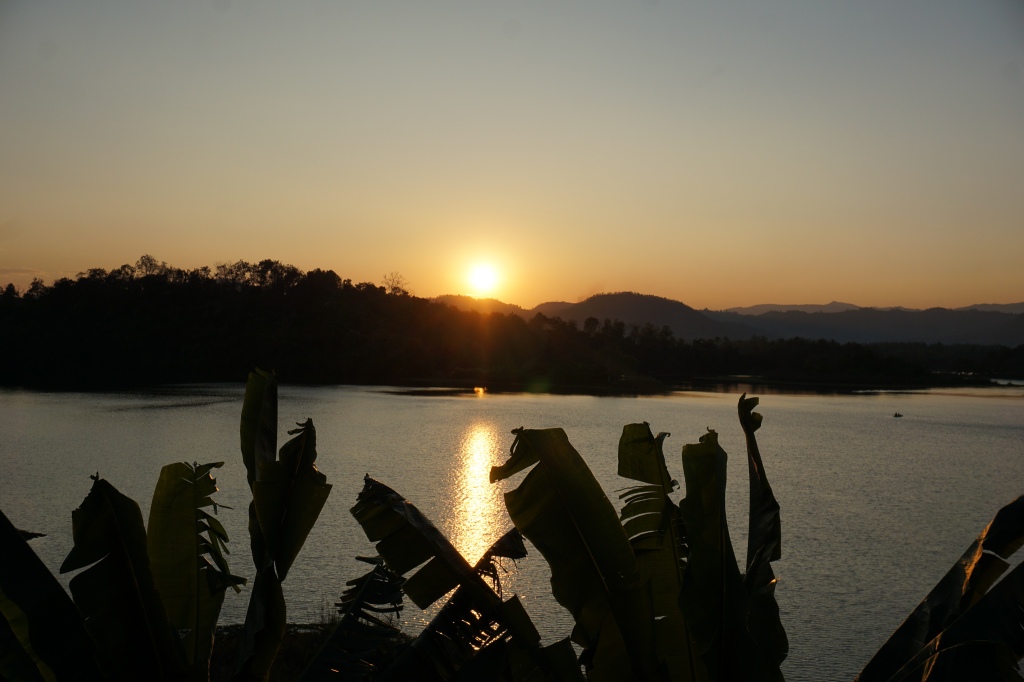

There was a big common area where we were having breakfast, lunch and dinners. I have to say the food was simply AMAZING. The guides were all incredibly professional, welcoming and knowledgeable, and you could feel a cosy ambience as they all operate as a family.
They have their offices in Luang Prabang, where you are picked up in their vans. From there, it’s about a 2.5 hours drive… the roads can be windy and are not in a good state. It’s also an eye-opener to the countryside of Laos.
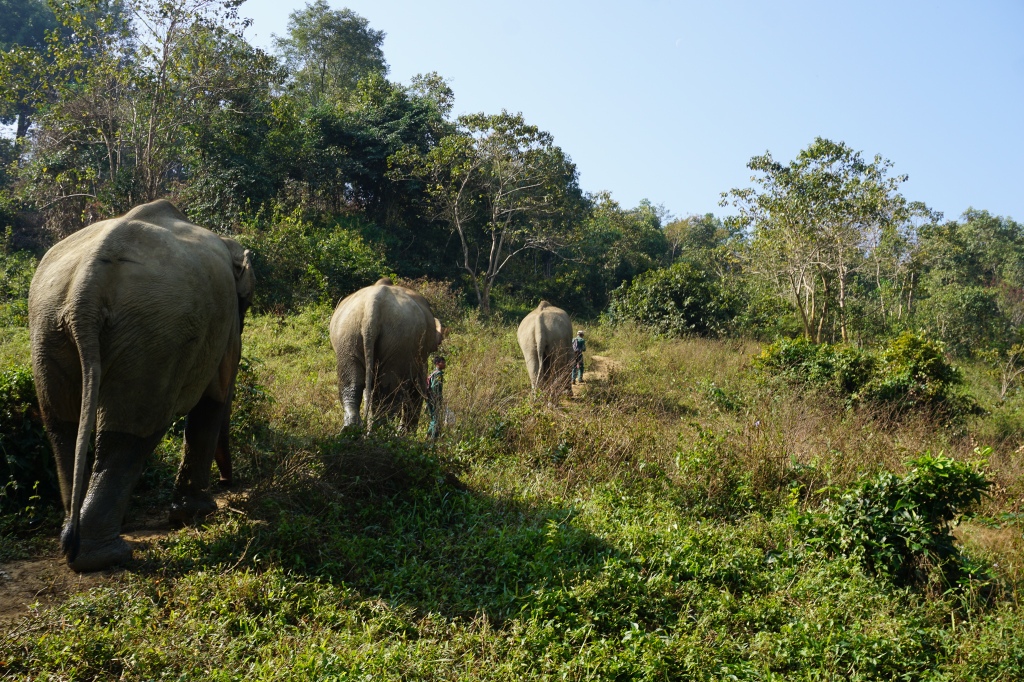

The Dangers the Asian Elephant Face
The Asian Elephant is in danger of extinction – and the numbers are shocking. It is estimated that at the beginning of the 20th century, there were around 100,000 in Asia – today, this number has dropped to something between 40,000 to 50,000 – a drop of over 50% in a century.
It is important to understand that in Laos the Asian Elephant has historically been regarded as a sacred animal, and in the early 20th century the country was known as the “Land of a Million Elephants” showcasing how big the population must have been back then. Unfortunately, it seems that this status of almost sanctity has been in part a danger to the elephants themselves. Even to this day, elephants are used in a myriad of religious ceremonies in Laos – one of them in the province of Sayaboury, where dozens of elephants participate in parades and are subjected to a lot of stress – the ECC, located in this province, is forced by the local authorities to also provide a few of its elephants to this festival, something they absolutely hate to do.

Today, about 400-600 wild elephants are roaming the lands of Laos, the country that used to be known as the land of the Million Elephants…
There are many causes for this, and it was all very well explained to us in the ECC.
- Habitat Loss & Human-Elephant Conflict – deforestation for agriculture, logging and development of infrastructure, robbing the elephants of their natural habitat. This leads to another factor contributing to their decline – human-elephant conflict. Because they lose their natural food sources with deforestation, they roam towards crops, and therefore farmers end up killing or gravely injuring the elephants.
- Poaching – despite the global ban on the ivory trade, elephants are still being targeted for their tusks, In addition to this, they are also being hunted for their body parts, which are used in some cultures for traditional medicine.
- Exploitation with Logging and Tourism – in Laos, these animals have been used in the logging and tourism industry, where they are subjected to incredibly harsh conditions, and forced to overwork. Elephants might not die directly from it, but they are put under a lot of stress and incapable of socialising with other elephants. This means they end up not reproducing, contributing to the decrease in the overall population. At the ECC, they have some elephants rescued from these conditions and it’s incredibly hard to rewild them.
It’s also important to note how difficult it is to end these practices. Some families rely on logging to survive, and for the elephant to be rescued from the industry, you’d have to pay a large sum to these families. The same happens with tourism – the difference is that we, tourists, can help to stop these practices if we simply don’t pay for them. Unfortunately, from what I have seen during my travels in Southeast Asia, this is far from happening.




The Sanctuaries
By definition, a sanctuary is a “refuge or safety from pursuit, persecution, or other danger”. You may look at the many photos of people smiling whilst petting an elephant, bathing with them, and feeding them, and see nothing wrong with that, and I wouldn’t blame you. Elephants are incredibly smart and empathetic creatures, and despite their size, it’s often overlooked how strong and dangerous they can be, especially if they are under stress, feel threatened or are in a state of aggression (male elephants can be quite aggressive during heat). We tend to assume (only humans can have this level of presumption) that the elephants are happy engaging with us, enjoying it, and even craving that attention. In reality, elephants who never got the chance to live in a community of their own, end up depending on humans to be fed and even to be given “work to do”, hence how hard it ends up being releasing them back into the wild. But we mustn’t forget that we have no right to force any animal to engage with us, even more so a wild animal such as an elephant. Yes, they are vegetarian and look like very innocent and naïve creatures. They won’t eat you. But they can still injure you very seriously, or even kill you, if one of them finally breaks down, fed up with all the human attention it’s forced to endure for hours and days on end. There have been some instances when this happened.

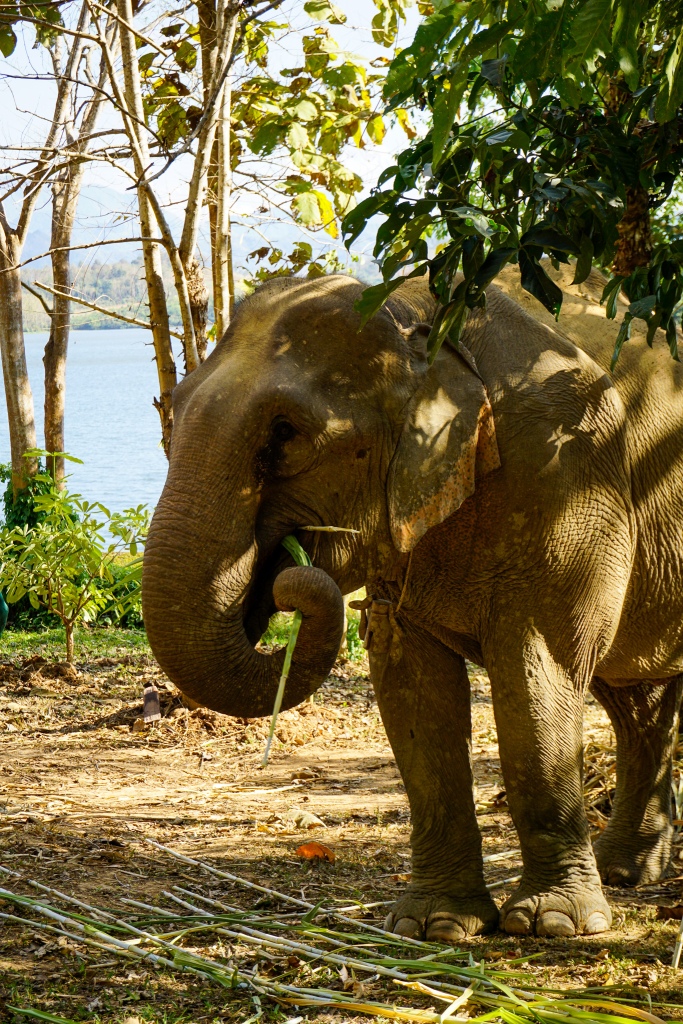

Any place where you are supposed to ride, pet, feed, and bathe elephants – just touching them really – can’t be a real sanctuary. A sanctuary is a place like the ECC – where elephants have been rescued, and there is amazing work being done for restoration. Remember – ultimately, the best place for the elephants to be is in the wild. Not between the limits of a fence, being forced to come out every day to be overfed. No being able to socialise with their own, learn how to survive in the wild and, most importantly, reproduce.

Without wanting to sound patronising – I used to believe sanctuaries were good places too – if you truly care about animals (as you should), support places like the ECC instead. Avoid any tours that include elephant sanctuaries or rides. Only by doing that can we help stop this practice. Also, beware – a lot of them claim to be ethical and sustainable, but they aren’t. It’s easy to put those words in leaflets, and inspections and audits aren’t as predominant as they’d be in Europe. In a nutshell – easy to lie and get away with it.
What about… voluntourism
If you don’t know what this is, it reflects the practice of travelling somewhere as a tourist and being a volunteer in an institution/organization. Collins Dictionary defines it as “tourism in which travellers do voluntary work to help communities or the environment in the places they are visiting“.
Typically, voluntourism activities have a very short duration and are paid (paid well, may I add) and this is what mostly differentiates this practice from standard volunteering programmes. As a voluntourist you are paying to volunteer… all you need is to have the money to do it. Not the qualifications. This concept never sat well with me. You can be a voluntourist in a wide range of different areas – and that includes animal welfare. Elephants included.
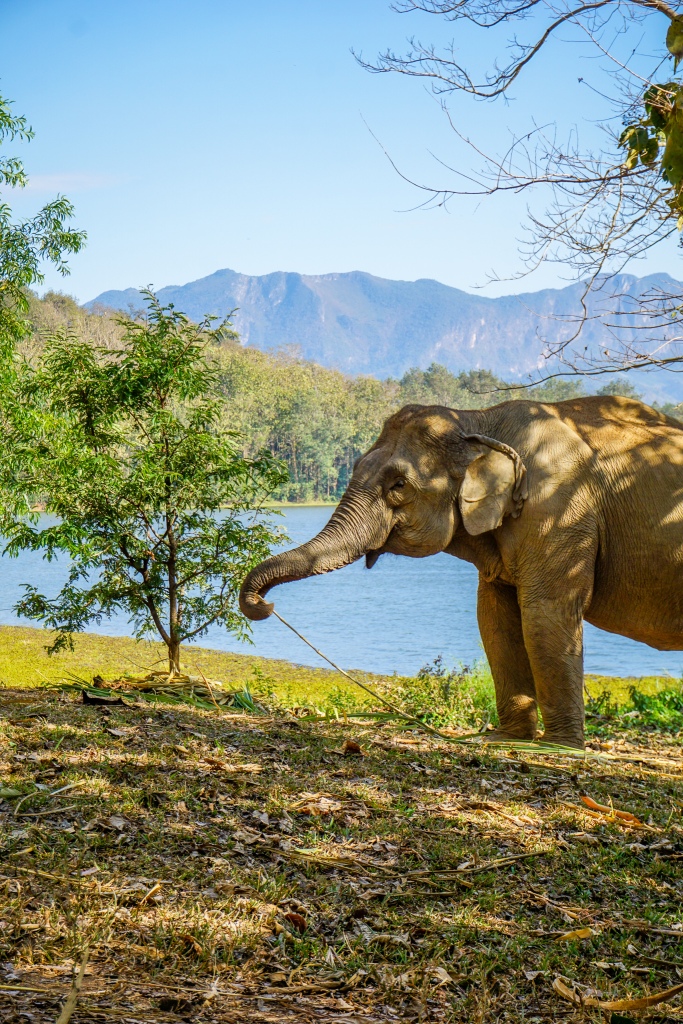




Whilst it can have some benefits – perhaps the money you pay really makes a difference, and of course, you hopefully get some training and learn something – the proliferation of this practice is likely more harmful than anything else. The harm is hidden behind good intentions. The reality is that the negative impacts on both the animals and the local communities can be devastating long term.
Firstly, if you as a foreigner, with money, and you are paying to work for free, this means that the organization won’t invest in hiring local professionals, training them and henceforth helping the community by keeping the money there. Because these voluntourism practices have taken off, and a lot of people are willing to pay a lot of money to do it, it also means places like this will proliferate… and are likely to poach and incarcerate more elephants for profit. Remember – the best for them is to be in the wild. Not to be incarcerated so you can take some photos to take home.


In addition (apologies for the bluntness) – who are you? What do you really know, in this case, about elephants? Did you study veterinary medicine or biology? Anything about conservation? Do you have any idea of what it really takes to take care of an elephant? Likely, you haven’t. A lot of volunteers want an experience to share on social media or want to go back home saying they spent a few days taking care of elephants for the sake of their CV. Most likely you won’t have any skills or knowledge, and whilst I’m sure you are full of good intentions, you can make mistakes that can seriously harm the animals. the fact that these programmes are so short, it means there is barely any training on site, and a lot of these programmes only last for a week or two. Perhaps a month, if we’re lucky.
It can also be stressful for elephants to constantly have to adapt to different humans. Elephants are extremely sensitive animals and we even like to believe they can build connections with humans – they are mammals after all and not that different from what we as humans may feel if every two weeks we had different caretakers.
In the ECC, the mahouts are hired from local families. In some cases, they come with the elephants, when these have been saved from logging. The veterinary, the researchers, guides, the cooks, the cleaners… they are all hired locals, who have been doing this job for years and have specialised in making sure they do it the best way they can.
Choose the ECC, or something like it 🙂
The ECC is a fantastic replacement for this – with programmes focused on education, you can tell the stories that need to be told about the Asian Elephant when you get back home, similar to what I’m doing here. Surely I don’t have any photos of me hugging the trunk of an elephant, or patting one on the head… but I’m only glad for it, especially after learning what I did in the Centre. You see… being a sustainable traveller means being conscious that it’s not all about YOU.


Staying at the ECC was one of the highlights of my four months in Southeast Asia. It was an experience I’ll never forget, and I learned so much. Those memories will stay with me, as well as the reinforced awareness of the dangers the Asian Elephants face every day. Being around such majestic and serene creatures, I won a new respect for these fellow mammals. We often talk about empathy between human beings. I say we’ve got to work on interspecies empathy as well.
Love, Nic
Thanks so much for this thoughtful post!
LikeLike
This is such a brilliant post, Nic! I find that seeking out cruelty-free experiences that prioritize animal welfare is crucial for preserving these remarkable species. Engaging in irresponsible animal interactions for human amusement such as petting tigers, riding elephants, or drinking snake wine further encourages the exploitation of precious wildlife. As some places confine captive animals and camouflage themselves as sanctuaries, rescue centres, and conservatories, you have to conduct research and book tours exclusively with registered nonprofits that rescue and rehabilitate captive animals with the goal of re-releasing them into the wild whenever possible. Thanks for sharing, and have a good day 🙂 Aiva xx
LikeLiked by 2 people
Thank you for reading Aiva, and this kind comment!
LikeLiked by 1 person